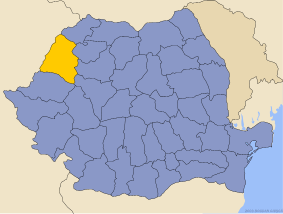Bihor County
| Bihor | |
|---|---|

| |
| Facts | |
| Region: | Transylvania |
| Capital city: | Oradea |
| Indicative: | BH |
| Population: | 600,223 as of 2002 |
| Population density: | 84 inh/km² |
| Area: | 7,544 km² |
| Web | County council County's prefecture |
| Telephone code | +40 x59 |
Bihor (Hungarian: Bihar) is a county (judeţ) in North-Western Romania, Western Transylvania in the Crişana region, with capital city at Oradea (population: 206,527).
Neighbours
- Sălaj County, Cluj County and Alba County in the East.
- Hungary in the West - Hajdú-Bihar County.
- Satu Mare County in the North.
- Arad County in the South.
Demographics
In 2002, Bihor had a population of 600,223 and the population density was 79.56/km². 48.6% of its population lives in urban areas, lower than the Romanian average.
Romanians make up to 67.40% of the county's population and Hungarians are the greatest and most important minority with 25.91%. The rest are Rromas (Gypsies) - 5.00%, Slovaks - 1.22% and Germans - 0.19%.
Geography
This county has a total area of 7,544 km².
In the East side of the County there are the Apuseni Mountains with heights up to 1800 m. The heights decrease westwards, passing through the hills an ending in the Romanian Western Plain - the eastern side of the Pannonian plain.
The county is mainly the Criş hydrographic basine with the rivers Crişul Repede, Crişul Negru and Barcău the main rivers.
Economy
Bihor is one of the wealthiest counties in Romania, with a GDP per capita well above the national average. Recently, the economy has been driven by a number of construction projects. Bihor has the lowest unemployment rate in Romania and among the lowest in Europe, with only 1.9% unemployment, compared to Romania's average of 5.5%. In 2003, 25.1% of the population lived below the national poverty line, a figure which is improving and is set to reach 20% in 2005.
The predominant industries in the county are:
- Textile industry.
- Food and beverages industry.
- Mechanical components industry.
- Metalurgy.
In the west side of the county there are mines for extracting coal and bauxite. Also crude oil is being extracted
Tourism
The main tourist attractions in the county are:
- The city of Oradea.
- The Apuseni Mountains:
- The Stâna de Vale Resort and the Iada valley.
- The Caves around Padiş and on the Sighiştel River Valley.
- The Bear's Cave.
- Băile Felix Resort.
Administrative divisions
The county has 4 municipalities, 6 towns and 90 communes.
Municipalities
Towns
Communes
Abram Abrămuţ Aştileu Auşeu Avram Iancu Balc Batăr Biharia Boianu Mare Borod Borş Bratca Brusturi Budureasa Buduslău Bulz Bunteşti Căbeşti Câmpani Căpâlna Cărpinet Cefa Ceica Cetariu Cherechiu Chişlaz Ciuhoi Ciumeghiu Cociuba Mare Copăcel Criştioru de Jos Curăţele Curtuişeni Derna Diosig Dobreşti [<a href="http://www.draganesti.ro">[Drăgăneşti]</a>] Drăgeşti Finiş Gepiu Girişu de Criş Hidişelu de Sus Holod Husasău de Tinca Ineu Lăzăreni Lăzuri de Beiuş Lugaşu de Jos Lunca Mădăraş Măgeşti Nojorid Olcea Oşorhei Paleu Pietroasa Pocola Pomezeu Popeşti Răbăgani Remetea Rieni Roşia Roşiori Sâmbăta Sânicolau Român Sânmartin Sântandrei Sârbi Săcădat Sălacea Sălard Spinuş Suplacu de Barcău Şimian Şinteu Şoimi Şuncuiuş Tărcaia Tămăşeu Tarcea Tăuteu Tileagd Tinca Tulca Ţeţchea Uileacu de Beiuş Vadu Crişului Vârciorog Viişoara
